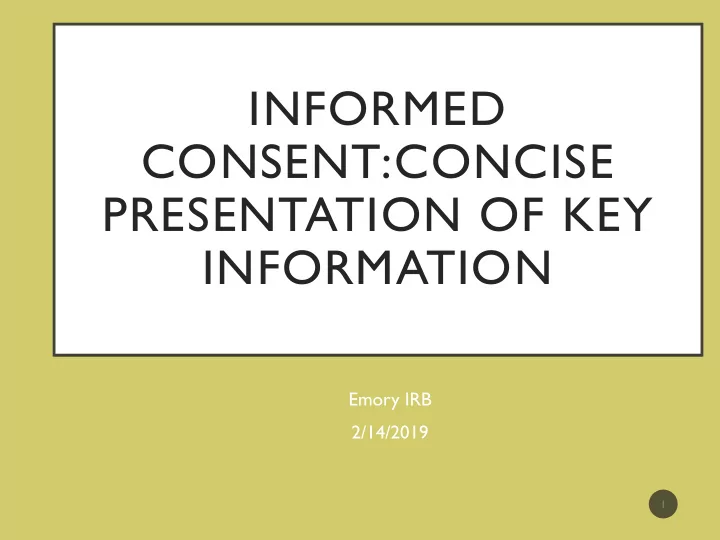

INFORMED CONSENT:CONCISE PRESENTATION OF KEY INFORMATION Emory IRB 2/14/2019 1
WHAT WILL BE COVERED IN THIS PRESENTATION? Common Rule’s New • Requirements- Key Summary SACHRP Recommendations • New Templates • Questions • 2
REGULATION CHANGES: Informed consent must begin with a concise and focused presentation of the key information that is most likely to assist a prospective subject or legally authorized representative in understanding the reasons why one might or might not want to participate in the research . This part of the informed consent must be organized and presented in a way that facilitates comprehension, and provides sufficient information that a “reasonable person” would want to have. Informed consent as a whole must present information in sufficient detail relating to the research, and must be organized and presented in a way that does not merely provide lists of isolated facts. 3
1. The fact that consent is being sought for research and that participation is voluntary 2. The purposes of the research, the expected duration of the prospective subject’s participation, and the procedures to be followed in the WHAT IS research “KEY INFORMATION”? 3. The reasonably foreseeable risks or discomforts to the prospective subject More Info In Preamble 4. The benefits to the prospective subject or to others that may reasonably be expected from the research 5. Appropriate alternative procedures or courses of treatments, if any, that might be advantageous to the prospective subject. 4
SECRETARY’S ADVISORY COMMITTEE ON HUMAN RESEARCH PROTECTIONS (SACHRP) Commentary on the New “Key BUT NO OFFICIAL Information” Informed Consent GUIDANCE YET Requirements October 17, 2018 The Secretary is responsible for regulatory oversight of the system for the protection of human subjects in biomedical and behavioral research supported or conducted by the Department of Health and Human Services (HHS). 5
SACHRP COMMENTARY • Electronic consent, audio, or video presentations may best present key information • Key information elements in preamble may not be sufficient: Flexibility is key May need to include • other elements or information May exclude elements • that won’t help with subject understanding 6
SACHRP COMMENTARY: BENEFITS • If applicable, include a statement that there are no direct benefits • Otherwise include an accurate and specific description of potential benefit • For clinical research, keep in mind the potential for therapeutic misconception- study’s primary goal is advancing knowledge and not delivering treatment • Avoid unclear language • Risks or potential benefits that would be used for decision on participation (in absence of more info) should be included 7
SACHRP COMMENTARY: RISKS Should refer to the • most important risks with regard to frequency and magnitude Avoid exhaustive • lists Clinical research: • include how risks differ from standard of care Discomforts and • inconveniences, rather than risks, might be key information (in SHB studies) 8
What are the main reasons a subject will want to join this SACHRP study? QUESTIONS TO What are the main reasons a HELP IDENTIFY subject will not want to join this KEY study? INFORMATION What is the research question the study is trying to answer? Why is it relevant to the subject? What aspects of research participation or this particular study are likely to be unfamiliar to a prospective subject, diverge from a subject’s expectations, or require special attention? 9
What information about the subject is being collected as part of this research? What are the types of SACHRP QUESTIONS TO activities that subjects will do HELP IDENTIFY in the research? KEY What impact will participating INFORMATION in this research have on the subject outside of the research? For example, will it reduce options for standard treatments? How will the subjects’ experience in this study differ from treatment outside of the study? In what ways is this research novel? 10
SACHRP COMMENTARY: LOGISTICS • Key information requirement will add to length of informed consent documents • No sections have been taken away • Key information does not need to be repeated in body of document • Unless repetition facilitates understanding 11
SACHRP COMMENTARY: LOGISTICS • Studies with simple design may have a concise enough informed consent document For now, if your study is federally • funded , you are required to complete this section • For other studies not federally funded, the IRB will use discretion for documents that are only 1-2 pages Document the highlights in summary: • risks/benefits and reason for study 12
EMORY CONCISE SUMMARY TEMPLATE Found in the website’s consent toolkit 13
OPTIONS TO ENHANCE READABILITY 14
QUESTIONS 15
TEAM Q INFORMATION • Education and QA Team • Maria G. Davila at (404)712-0724 or maria.davila@emory.edu • Shara Karlebach at (404)712-0727 or shara.karlebach@emory.edu • Jessica Blackburn at (404) 712-9698 or jessica.blackburn@emory.edu • Clarissa Dupree at (404) 727-8864 or cdupree@emory.edu 16
Recommend
More recommend